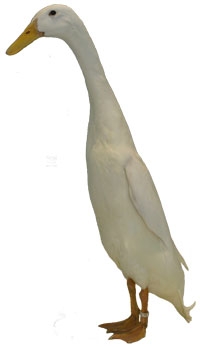
General Information
It is an egg-producing breed. The breed further has three standard varieties. It is a layer that gives an average yield of 250 eggs/annum. It is second to Khaki Campbell in egg production. The three standard varieties of this breed are as follows:
• The fawn and white runner: They have a white colour neck, fawn-coloured back and shoulders, long and narrow body, and full breasts, body is similar to a penguin’s shape and orange-red colour shanks and toes. The bill has a variety of colours at different stages i.e. Young Drake has a yellow colour bill which becomes greenish yellow in later stages and Young Duck has a yellow colour bill that becomes dull green in later stages.
• The white runner: It has a pure white colour in all sections. It has a yellow bill and orange colour shanks and toes.
• The pencilled variety: The male has a dull bronze-green and white colour head, softback and dull bronze colour tail. The female has a medium fawn and white colour head, a fawn colour with light lines on the edges of the feathers and the plumage is the same as the male duck.
Feed
Feeding baby ducklings: The feed of ducklings having an age of 3 weeks must include 2700 kilo calorie/kg of metabolizable energy and 20% protein content. After the age of 3 weeks, the protein level must be 18%. The duck requires 50-60kg of feed in one year. Producing 1 dozen eggs and 2kg broiler duck requires approximately 3kg of feed.
Feeding ducks: Ducks are excessively greedy eaters and are attractive in look. Along with feed they also eat earthworms, insects and greenish material present in water. When ducks are brought up in the shed, give them wet feed because it is difficult for them to eat dry feed. The feed is converted into 3mm tablets which are good for ducks to give them as a feed.
Feed to egg-laying ducks: The laying ducks require about 16-18% of protein content in the feed. Mainly an egg-laying duck eats 6-8 ounces of feed. But the amount may vary depending upon the duck’s breed. Clean and fresh water must be provided to ducks at all times. Fruits, vegetables, corn, and small insects can be given in the feed as an extra supplement. Always try to give water along with feed as it will help the duck to easily consume the feed.
Care of the breed
Shelter and care: It requires shelter which is quiet and secluded. It should be well-ventilated and should have enough space so that ducks can easily expand their wings and groom. Clean and fresh water must be always available to the ducklings. Water fountains are recommended to the ducklings for fresh water.
Care of ducklings: After hatching ducklings require a brooder which has a temperature of 90°F and then it should be lowered by 5°C every day. After some days when the temperature will match the room temperature then the ducklings are taken out from the brooder. Proper feed at proper intervals of time must be given to chicks and clean water must be available every time in the brooder.
Care of laying ducks: For proper growth of ducks and production of good quality eggs, proper care of ducks is required. Mash or pellets are given in the feed at the proper time. For the production of good quality eggs, 18% of protein content is required in the feed. Mainly an egg-laying duck consumes 6-8 ounces of feed. Don’t give bread to ducks or ducklings in the feed.
Recommended vaccines: Proper vaccination at proper intervals of time is necessary.
• Duck cholera (Pasteurellosis) vaccination @1ml is given to ducklings when it is 3-4 weeks old to prevent cholera disease.
• Duck plague vaccination @1ml is given to ducklings when it is 8-12 weeks old to prevent plague disease.
Diseases and Treatment
• Duck virus hepatitis: It is a highly contagious disease which is caused by the herpes virus. It mainly occurs in young ducklings which is 1-28 days old. They caused internal breeding, severe diarrhoea and then ultimately death of the infected bird.
Treatment: No treatment is there once this disease gets infected. For prevention, vaccination of live virus duck hepatitis is given to the breeder ducks to prevent duck virus hepatitis.
• Duck plague (Duck Virus Enteritis): It is a contagious and highly fatal disease. The disease is mainly caused in both mature and young ducks. The symptoms are sluggishness, greenish-yellow colour diarrhoea and ruffled feathers. The signs of this disease are spots that appear on the mucous lining of the oesophagus and intestines.
Treatment: Vaccination of attenuated live duck virus enteritis is given to cure duck plague.
• Salmonella: The signs of this disease are depression, closed eyes, lameness, ruffled feathers etc.
Treatment: Vaccination of Amoxicillin is given to treat salmonella.
• Aflatoxicosis: It is a fungal disease. It is mainly caused by to consumption of high moisture grains which contain Alfa toxins. The symptoms are sleepiness, depressed growth, paleness, increased bruising and decreased fertility.
Treatment: Increase the protein, vitamin content and mineral content by 1% in the feed. The addition of Gentian violet will help to reduce the effect of Alfatoxicosis disease.
• Duck pox: The symptom is the retarted growth. Duck pox is of two types: dry and wet type. In dry pox, the symptoms are wart-like bruises found on the skin and they heal in 2 weeks. In wet pox, blight-like lesions are observed near Bill.
Treatment: Spraying of mosquito repellant or suitable vaccination is given to cure the disease.
• Riemerella anatipestifer infection: It is a bacterial disease. The symptoms are weight loss, diarrhoea which is blood stained sometimes, shaking head, twisted neck and a high mortality rate.
Treatment: Vaccination of enrofloxacin, Penicillin and sulfadimethoxine-ormetoprim @0.04-0.08% is given in the feed to cure this disease.
• Colibacillosis: It is a common infectious disease that is caused by E. coli. Its main sign is that it reduces hatchability.
Treatment: Medicine of Chlorotetracycline @0.04% and Sulfadimethoxine-ormetoprim @0.04-0.08% is given in feed to cure Colibacillosis disease.
Financial and Business expert having 30+ Years of vast experience in running successful businesses and managing finance.





